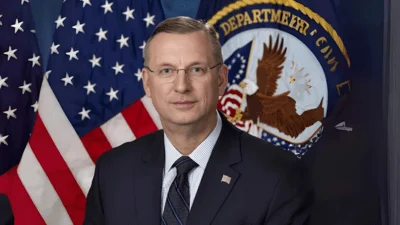The U.S. Securities and Exchange Commission (SEC) has stepped up its enforcement actions in the cryptocurrency industry after the November bankruptcy filing of crypto exchange FTX and has recently begun targeting stablecoins, sparking concerns that the industry could shift away from the U.S. dollar and peg itself to a different country's currency.
Timothy Massad, a research fellow at the Harvard Kennedy School Mossavar-Rahmani Center for Business and Government and the director of the M-RCBG Digital Assets Policy Project, said U.S. regulators need to iron out stablecoin regulations so domestic technological innovation can continue to ensure that the dollar remains the dominant currency in global transactions. Massad also is the former chairman of the U.S. Commodity Futures Trading Commission.
Stablecoins are cryptocurrencies with a value that is pegged to a commodity or currency such as the U.S. dollar, according to the Federal Reserve. Stablecoins’ “stabilization methods” are designed to ensure that the value of the asset avoids the volatility that can affect other cryptocurrencies. The Fed notes that stablecoins are a key part of the decentralized finance (DeFi) ecosystem and can be used in transactions for goods and services. More than 80% of trades on major crypto exchanges involve stablecoins.
"We should be deciding what is the proper way to regulate stablecoins from a functional standpoint rather than having a wrestling match between regulators," Massad said in a statement. "I think any stablecoin that does not pay interest should be regulated as a payment mechanism under bank-like standards."
The U.S. Securities and Exchange Commission (SEC) has stepped up its enforcement actions in the crypto industry after the November bankruptcy filing of crypto exchange FTX, and it recently turned its attention to stablecoins, Reuters reported. In February, the SEC told the blockchain platform Paxos Trust Company to stop issuing the stablecoin Binance USD (BUSD), asserting that stablecoins are securities and BUSD should have been registered as such. Some crypto experts suggested that the move against BUSD, which is the third-biggest stablecoin in circulation, is evidence that the SEC is trying to bring more of the digital asset ecosystem under its control in the absence of comprehensive legislation detailing how stablecoins should be regulated.
"Within the broader enforcement trends that we're seeing, the SEC is really asserting a lot of jurisdiction and it's trying to bring as much of this activity within its control, I think as it can reasonably do at this point," said Jason Allegrante, chief legal and compliance officer at the digital asset platform Fireblocks.
Georgia Quinn, who spoke in front of the President’s Working Group on Financial Markets in November 2021, wrote in an opinion piece for Law360 that it is critical to understand that stablecoins are a technological evolution of our fiat currency, backed one-to-one by currency held in reserve. As such, they are not subject to the volatility that can affect other types of cryptocurrencies, and they do not pose a risk of destabilizing the U.S. financial system, as some lawmakers have expressed concerns over.
Instead, Quinn wrote that stablecoins present an opportunity to solidify “the global prominence of the U.S. dollar in a new, digital era.” More than 90% of the stablecoins in the world are backed by the U.S. dollar. Amidst current global geopolitical tensions, American leadership in the realm of stablecoins can serve as a national security tool to ensure that the dollar retains its prominence in the global digital asset market. However, Quinn warned that if the U.S. does not embrace stablecoins, other countries will step up, and other currencies could supplant the dollar, “allowing for other countries’ trade denomination and reserves to become the new de facto choices.” Quinn wrote that if the world’s stablecoin market is driven by the U.S. dollar, it will support America’s role as the leader in global capital markets, monetary policy and the digital asset ecosystem.
"The global dominance of the dollar is not driven by technology, but we do need to think about the effects of technological development on the primacy of the dollar in international payments and in particular the importance of dollar-based payment systems," Massad said. "Dollar-based stablecoins might be useful in that regard, and that’s a reason why we should create a regulatory framework that addresses the risks they pose but also allows for innovation. Moreover, there is a risk that dollar-based stablecoins could be launched from other jurisdictions that are creating such frameworks — it could be the crypto equivalent of the beginnings of the Eurodollar market.
"Those U.S. interests could be impacted if there is a decline in the use of dollar-based payment systems. That could happen over a period of years even if the dollar remains the world’s reserve currency and dollar-based investments are still seen as the safest assets in times of stress. There are efforts in other countries to develop alternatives to dollar-based systems, using digital assets or conventional means. That’s why we need to make sure the technology of dollar-based payments keeps up."
Although China and Russia have banned the use of cryptocurrencies, the leadership of both countries recognizes that digital currency will play a critical role in the future of the global economy. Both countries have developed state-owned digital currencies called CBDCs (central bank digital currencies), which are pegged one-to-one to their fiat counterparts, according to Georgia Quinn, general counsel for Anchorage Digital. Quinn recommends that the U.S. cement stablecoin regulations and that American stablecoin issuers voluntarily participate in regulation and supervision. These steps will enable the U.S. stablecoin market to continue to drive innovation and economic activity. The U.S. dollar serving as the main fiat currency tied to stablecoins worldwide will support American national stability by “further bolster[ing] U.S. dollar prominence over other potential competitors in the global digital asset ecosystem over the long term.”
In an episode of the podcast Unchained, Miller Whitehouse-Levine, policy director of the DeFi Education Fund, said governments should be aware that they do not necessarily need to adopt another country's digital currency for its businesses to start using it. "For example, China could predicate market access on foreign businesses using the ERB to do business and to take their assets out of the country. And I think, you know, given the evidence of the U.S. businesses' approach to China, that wouldn't be a terribly high cost in the minds of many business leaders," Whitehouse-Levine said.









